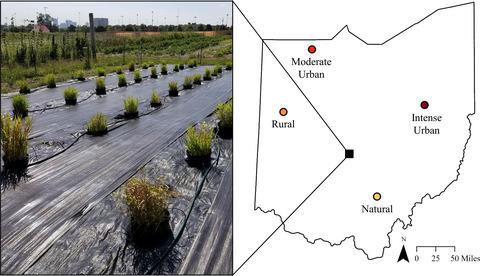当前位置:
X-MOL 学术
›
Ecol. Evol.
›
论文详情
Our official English website, www.x-mol.net, welcomes your
feedback! (Note: you will need to create a separate account there.)
Potential local adaptation in populations of invasive reed canary grass (Phalaris arundinacea) across an urbanization gradient
Ecology and Evolution ( IF 2.3 ) Pub Date : 2021-07-28 , DOI: 10.1002/ece3.7938 Leah M Weston 1 , Kali Z Mattingly 1 , Charles T C Day 2 , Stephen M Hovick 1
Ecology and Evolution ( IF 2.3 ) Pub Date : 2021-07-28 , DOI: 10.1002/ece3.7938 Leah M Weston 1 , Kali Z Mattingly 1 , Charles T C Day 2 , Stephen M Hovick 1
Affiliation

|
Urban stressors represent strong selective gradients that can elicit evolutionary change, especially in non-native species that may harbor substantial within-population variability. To test whether urban stressors drive phenotypic differentiation and influence local adaptation, we compared stress responses of populations of a ubiquitous invader, reed canary grass (Phalaris arundinacea). Specifically, we quantified responses to salt, copper, and zinc additions by reed canary grass collected from four populations spanning an urbanization gradient (natural, rural, moderate urban, and intense urban). We measured ten phenotypic traits and trait plasticities, because reed canary grass is known to be highly plastic and because plasticity may enhance invasion success. We tested the following hypotheses: (a) Source populations vary systematically in their stress response, with the intense urban population least sensitive and the natural population most sensitive, and (b) plastic responses are adaptive under stressful conditions. We found clear trait variation among populations, with the greatest divergence in traits and trait plasticities between the natural and intense urban populations. The intense urban population showed stress tolerator characteristics for resource acquisition traits including leaf dry matter content and specific root length. Trait plasticity varied among populations for over half the traits measured, highlighting that plasticity differences were as common as trait differences. Plasticity in root mass ratio and specific root length were adaptive in some contexts, suggesting that natural selection by anthropogenic stressors may have contributed to root trait differences. Reed canary grass populations in highly urbanized wetlands may therefore be evolving enhanced tolerance to urban stressors, suggesting a mechanism by which invasive species may proliferate across urban wetland systems generally.
中文翻译:

跨城市化梯度入侵芦苇金丝雀草(Phalaris arundinacea)种群的潜在局部适应
城市压力源代表了强烈的选择性梯度,可以引发进化变化,特别是对于可能存在巨大种群内变异性的非本地物种。为了测试城市压力源是否会驱动表型分化并影响局部适应,我们比较了无处不在的入侵者芦苇金丝雀草( Phalaris arundinacea )种群的压力反应。具体来说,我们量化了从跨越城市化梯度(自然、农村、中等城市和密集城市)的四个群体收集的芦苇金丝雀草对盐、铜和锌添加的反应。我们测量了十个表型性状和性状可塑性,因为已知芦苇金丝雀草具有高度可塑性,而且可塑性可能会提高入侵成功率。我们测试了以下假设:(a)来源人群的压力反应存在系统差异,密集的城市人群最不敏感,自然人群最敏感,(b)可塑性反应在压力条件下具有适应性。我们发现人群之间存在明显的性状变异,自然人口和密集城市人群之间的性状和性状可塑性差异最大。密集的城市人口表现出资源获取性状的胁迫耐受特征,包括叶片干物质含量和特定根长度。超过一半的测量特征在人群中的性状可塑性存在差异,这凸显了可塑性差异与性状差异一样普遍。根质量比和特定根长度的可塑性在某些情况下是适应性的,这表明人为应激源的自然选择可能导致根性状差异。 因此,高度城市化湿地中的芦苇金丝雀草种群可能正在进化出对城市压力源的更强的耐受性,这表明入侵物种可能在整个城市湿地系统中普遍扩散的机制。
更新日期:2021-08-16
中文翻译:

跨城市化梯度入侵芦苇金丝雀草(Phalaris arundinacea)种群的潜在局部适应
城市压力源代表了强烈的选择性梯度,可以引发进化变化,特别是对于可能存在巨大种群内变异性的非本地物种。为了测试城市压力源是否会驱动表型分化并影响局部适应,我们比较了无处不在的入侵者芦苇金丝雀草( Phalaris arundinacea )种群的压力反应。具体来说,我们量化了从跨越城市化梯度(自然、农村、中等城市和密集城市)的四个群体收集的芦苇金丝雀草对盐、铜和锌添加的反应。我们测量了十个表型性状和性状可塑性,因为已知芦苇金丝雀草具有高度可塑性,而且可塑性可能会提高入侵成功率。我们测试了以下假设:(a)来源人群的压力反应存在系统差异,密集的城市人群最不敏感,自然人群最敏感,(b)可塑性反应在压力条件下具有适应性。我们发现人群之间存在明显的性状变异,自然人口和密集城市人群之间的性状和性状可塑性差异最大。密集的城市人口表现出资源获取性状的胁迫耐受特征,包括叶片干物质含量和特定根长度。超过一半的测量特征在人群中的性状可塑性存在差异,这凸显了可塑性差异与性状差异一样普遍。根质量比和特定根长度的可塑性在某些情况下是适应性的,这表明人为应激源的自然选择可能导致根性状差异。 因此,高度城市化湿地中的芦苇金丝雀草种群可能正在进化出对城市压力源的更强的耐受性,这表明入侵物种可能在整个城市湿地系统中普遍扩散的机制。









































 京公网安备 11010802027423号
京公网安备 11010802027423号